The Impact of Postoperative Urinary Diversion on Surgical Outcomes of Hypospadias Repair: A Systematic Review and Meta-Analysis of Pediatric Literature
Abstract
1. Introduction
2. Materials and Methods
2.1. Search Strategy
2.2. Study Selection
- -
- Patient/Problem: Pediatric patients diagnosed with hypospadias (age ≤ 18 years).
- -
- Intervention: Hypospadias repair with urinary diversion (bladder catheter or urethral stent).
- -
- Comparison/Control: Hypospadias repair without urinary diversion (unstented procedures).
- -
- Outcome(s): Urethrocutaneous fistula/dehiscence rate, meatal/urethral stenosis rate, rate of other postoperative complications, diversion-related mechanical and functional complications, and re-operation rates.
2.3. Data Extraction
2.4. Study Endpoints
2.5. Risk of Bias Assessment
2.6. Statistical Analysis
3. Results
3.1. Study and Patient Characteristics
3.2. Urinary Diversion Types
3.3. Postoperative Outcomes
3.4. Meta-Analysis of Outcomes
3.4.1. Bladder Catheter vs. Urethral Stent
3.4.2. Stented vs. Unstented Procedures
3.4.3. Catheterization Length ≤ 5 Days vs. Catheterization Length > 5 Days
3.5. Publication Bias
4. Discussion
5. Conclusions
Supplementary Materials
Author Contributions
Funding
Institutional Review Board Statement
Informed Consent Statement
Data Availability Statement
Conflicts of Interest
Abbreviations
| PRISMA | Preferred Reporting Items for Systematic Reviews and Meta-analyses |
| RCT | Randomized controlled trial |
| UCF | Urethrocutaneous fistula |
| AUR | Acute urinary retention |
| OR | Odds ratio |
| CI | Confidence interval |
| WI | Wound infection |
| UTI | Urinary tract infection |
References
- Castagnetti, M.; El-Ghoneimi, A. Surgical management of primary severe hypospadias in children: An update focusing on penile curvature. Nat. Rev. Urol. 2022, 19, 147–160. [Google Scholar] [CrossRef] [PubMed]
- van der Horst, H.J.; de Wall, L.L. Hypospadias, all there is to know. Eur. J. Pediatr. 2017, 176, 435–441. [Google Scholar] [CrossRef] [PubMed]
- Springer, A.; Krois, W.; Horcher, E. Trends in hypospadias surgery: Results of a worldwide survey. Eur. Urol. 2011, 60, 1184–1189. [Google Scholar] [CrossRef] [PubMed]
- Jesus, L.E.; Pippi-Salle, J.L. Managing hypospadias failure: A comprehensive review of strategies and outcomes. Actas Urol. Esp. (Engl. Ed). 2025, 49, 501809. [Google Scholar] [CrossRef]
- Ru, W.; Tang, D.; Wu, D.; Tao, C.; Chen, G.; Wei, J.; Tian, H.; Shu, Q. Identification of risk factors associated with numerous reoperations following primary hypospadias repair. J. Pediatr. Urol. 2021, 17, 61.e1–61.e5. [Google Scholar] [CrossRef]
- Hardman, L.; Murray, E.; Bakare, S.; Mackenzie, D.; Wilson-Jones, N.; Armstrong, A. Hypospadias: The lay of the land. J. Plast. Reconstr. Aesthet. Surg. 2025, 102, 145–148. [Google Scholar] [CrossRef]
- Chua, M.; Welsh, C.; Amir, B.; Silangcruz, J.M.; Ming, J.; Gnech, M.; Sanger, S.; Lorenzo, A.; Braga, L.H.; Bägli, D. Non-stented versus stented urethroplasty for distal hypospadias repair: A systematic review and meta-analysis. J. Pediatr. Urol. 2018, 14, 212–219. [Google Scholar] [CrossRef]
- Radmayr, C.; Bogaert, G.; Bujons, A.; Burgu, B.; Castagnetti, M.; ‘t Hoen, L.A.; O’Kelly, F.; Pakkasjärvi, N.A.; Quaedackers, J.; Rawashdeh, Y.F.H.; et al. EAU Guidelines on Paediatric Urology. Edn. Presented at the EAU Annual Congress Paris 2024. Available online: https://uroweb.org/guidelines/paediatric-urology (accessed on 9 September 2025).
- Hakim, S.; Merguerian, P.A.; Rabinowitz, R.; Shortliffe, L.D.; McKenna, P.H. Outcome analysis of the modified Mathieu hypospadias repair: Comparison of stented and unstented repairs. J. Urol. 1996, 156 Pt 2, 836–838. [Google Scholar] [CrossRef]
- Arda, I.S.; Mahmutoğlu, M. Urethral catheterization in hypospadias surgery: Should the device enter the bladder or be made a urethral stent? J. Pediatr. Surg. 2001, 36, 1829–1831. [Google Scholar] [CrossRef]
- El-Sherbiny, M.T. Tubularized incised plate repair of distal hypospadias in toilet-trained children: Should a stent be left? BJU Int. 2003, 92, 1003–1005. [Google Scholar] [CrossRef]
- Lorenz, C.; Schmedding, A.; Leutner, A.; Kolb, H. Prolonged stenting does not prevent obstruction after TIP repair when the glans was deeply incised. Eur. J. Pediatr. Surg. 2004, 14, 322–327. [Google Scholar] [CrossRef]
- Leclair, M.D.; Camby, C.; Battisti, S.; Renaud, G.; Plattner, V.; Heloury, Y. Unstented tubularized incised plate urethroplasty combined with foreskin reconstruction for distal hypospadias. Eur. Urol. 2004, 46, 526–530. [Google Scholar] [CrossRef]
- Aslan, A.R.; Yücebaş, E.; Tekin, A.; Sengör, F.; Kogan, B.A. Short-term catheterization after TIP repair in distal hypospadias: Who are the best candidates? Pediatr. Surg. Int. 2007, 23, 265–269. [Google Scholar] [CrossRef] [PubMed]
- Almodhen, F.; Alzahrani, A.; Jednak, R.; Capolicchio, J.P.; El Sherbiny, M.T. Nonstented tubularized incised plate urethroplasty with Y-to-I spongioplasty in non-toilet trained children. Can. Urol. Assoc. J. 2008, 2, 110–114. [Google Scholar] [CrossRef] [PubMed]
- Ritch, C.R.; Murphy, A.M.; Woldu, S.L.; Reiley, E.A.; Hensle, T.W. Overnight urethral stenting after tubularized incised plate urethroplasty for distal hypospadias. Pediatr. Surg. Int. 2010, 26, 639–642. [Google Scholar] [CrossRef] [PubMed]
- Chang, P.C.; Yeh, M.L.; Chao, C.C.; Chang, C.J. Use of double pigtail stent in hypospadias surgery. Asian J. Surg. 2011, 34, 28–31. [Google Scholar] [CrossRef]
- Turial, S.; Enders, J.; Engel, V.; Schier, F. Stent-free tubularized incised plate (TIP) repair of distal and mid-shaft hypospadias irrespective of age. Eur. J. Pediatr. Surg. 2011, 21, 168–170. [Google Scholar] [CrossRef]
- Radwan, M.; Soliman, M.G.; Tawfik, A.; Abo-Elenen, M.; El-Benday, M. Does the type of urinary diversion affect the result of distal hypospadias repair? A prospective randomized trial. Ther. Adv. Urol. 2012, 4, 161–165. [Google Scholar] [CrossRef]
- Xu, N.; Xue, X.Y.; Wei, Y.; Li, X.D.; Zheng, Q.S.; Jiang, T.; Huang, J.B. Outcome analysis of tubularized incised plate repair in hypospadias: Is a catheter necessary? Urol. Int. 2013, 90, 354–357. [Google Scholar] [CrossRef]
- Chalmers, D.J.; Siparsky, G.L.; Wiedel, C.A.; Wilcox, D.T. Distal hypospadias repair in infants without a postoperative stent. Pediatr. Surg. Int. 2015, 31, 287–290. [Google Scholar] [CrossRef]
- Polat, H.; Yucel, M.O.; Cift, A.; Gok, A.; Benlioglu, C.; Lok, U.; Gulacti, U. The use of latex foley catheter in repair of hypospadias the most common seen congenital penile anomaly. Int. J. Clin. Exp. Med. 2015, 8, 13421–13423. [Google Scholar]
- Daher, P.; Khoury, A.; Riachy, E.; Atallah, B. Three-week or one-week bladder catheterization for hypospadias repair? A retrospective-prospective observational study of 189 patients. J. Pediatr. Surg. 2015, 50, 1063–1066. [Google Scholar] [CrossRef] [PubMed]
- Ozcan, S.; Bagcioglu, M.; Karakan, T.; Diri, M.A.; Demirbas, A. Efficacy of using Zaontz urethral stent in hypospadias repair by the Face, Legs, Activity, Cry, Consolability (FLACC) scale: A prospective study. Can. Urol. Assoc. J. 2017, 11, E15–E18. [Google Scholar] [CrossRef] [PubMed]
- Karakaya, A.E.; Doğan, A.B.; Güler, A.G. Use of a Stent in Distal Hypospadias Repaired by Tubularized Incised Plate Urethroplasty: A Comparative Study. Urol. Int. 2019, 102, 336–340. [Google Scholar] [CrossRef]
- El-Karamany, T.M.; Al-Adl, A.M.; Omar, R.G.; Abdel Aal, A.M.; Eldakhakhny, A.S.; Abdelbaki, S.A. A Critical Analysis of Stented and Unstented Tubularized Incised Plate Urethroplasty Through a Prospective Randomized Study and Assessment of Factors Influencing the Functional and Cosmetic Outcomes. Urology 2017, 107, 202–208. [Google Scholar] [CrossRef]
- Scarpa, M.G.; Perin, G.; Di Grazia, M.; Codrich, D.; Pederiva, F.; Guida, E.; Lembo, M.A.; Giannotta, A.; Schleef, J. Surgery for distal hypospadias: What about the catheter? Pediatr. Med. Chir. 2017, 39, 145. [Google Scholar] [CrossRef][Green Version]
- Lee, L.C.; Schröder, A.; Bägli, D.J.; Lorenzo, A.J.; Farhat, W.A.; Koyle, M.A. Stent-related complications after hypospadias repair: A prospective trial comparing Silastic tubing and Koyle urethral stents. J. Pediatr. Urol. 2018, 14, 423.e1–423.e5. [Google Scholar] [CrossRef]
- Sarac, M.; Bakal, U.; Tartar, T.; Canpolat, S.; Kazez, A. Is stent type used in snodgrass method a factor in fistula formation? Niger. J. Clin. Pract. 2018, 21, 1198–1202. [Google Scholar] [CrossRef]
- Assadi, A.; Alzubaidi, A.N.; Cline, J.K.; Sharadin, C.; Travis, A.J.; Marley, K.; Dewan, C.; Gleason, J.M. Nonstented Tubularized Incised Plate Distal Hypospadias Repair: A Single Center 5 Years’ Experience. Urology 2020, 146, 207–210. [Google Scholar] [CrossRef]
- Almusafer, M.; Abduljabbar, O.H.; Buchholz, N. Stented versus Non-Stented Snodgrass Urethroplasty for Distal Hypospadias Repair. Urol. Int. 2020, 104, 156–159. [Google Scholar] [CrossRef]
- Honkisz, I.; Sulisławski, J.; Dobrowolska-Glazar, B.; Kuijper, C.F.; Chrzan, R. Foreskin healing after distal hypospadias repair: Does stenting affect the outcome? Adv. Clin. Exp. Med. 2020, 29, 1487–1490. [Google Scholar] [CrossRef]
- Scarpa, M.G.; Codrich, D.; Iaquinto, M.; Guida, E.; Cerrina, A.; Schleef, J. Medium-term outcome after stented and un-stented distal urethroplasty: A retrospective analysis on redo-urethroplasty need and cosmetic results. Actas Urol. Esp. (Engl. Ed). 2021, 45, 642–647. [Google Scholar] [CrossRef] [PubMed]
- Abdel-Hamid El-Hawy, M.; Ali, M.M.; Abdelhamid, A.M.; Fawzy, A.M.; Hussein, A.; Elsharkawy, M.S.M. Long-term outcome of non-stented tubularized incised plate urethroplasty for distal hypospadias repair: A complication analysis. Cent. Eur. J. Urol. 2021, 74, 595–600. [Google Scholar]
- Burki, T.; Al Hams, A.W.; Nazer, A.; Mojallid, A.; Abasher, A.; Jamalalail, Y.; Al Modhen, F.; Al Shammari, A. Outcome of stented versus unstented mid-shaft to distal hypospadias repair. Urol. Ann. 2022, 14, 147–151. [Google Scholar] [CrossRef]
- Kumar, A.; Ram Dhayal, I. A Comparative Study on the Outcomes of Hypospadias Surgery Following Early Versus Late Bladder Catheter Removal. Cureus 2022, 14, e26104. [Google Scholar] [CrossRef]
- Zhou, S.; Zhang, J.; Zhang, J.; Xiao, X.; Su, Z.; Liu, M.; Huang, Z.; Tian, D.; Liang, W.; Zhang, J. Impact of Two Urethral Stent Types on Complications after One-Stage Hypospadias Repair Using the Duckett Procedure. Plast. Reconstr. Surg. 2024, 153, 1123–1131. [Google Scholar] [CrossRef]
- Seguier-Lipszyc, E.; Shumaker, A.; Stav, K.; Itshak, A.; Neheman, A. The introduction of a mid-urethral stent for hypospadias surgery in toilet-trained children. Pediatr. Surg. Int. 2024, 40, 254. [Google Scholar] [CrossRef]
- Zhou, G.; Jiang, M.; Liu, X.; Yin, J.; Yang, Z.; Li, S.; Chen, J. Effect of Prolonging the Duration of Stenting on Urethral Stricture in Proximal Hypospadias with Severe Curvature Repair: A Prospective Cohort Study. Eur. J. Pediatr. Surg. 2024, 34, 363–367. [Google Scholar] [CrossRef]
- Fuentes Carretero, S.; Grande Moreillo, C.; Vicente Sánchez, N.; Margarit Mallol, J. Postoperative care in hypospadias. Common practices and evidence available. Cir. Pediatr. 2024, 37, 79–83. [Google Scholar] [CrossRef]
- Hardwicke, J.; Jones, E.; Wilson-Jones, N. Optimization of silicone urinary catheters for hypospadias repair. J. Pediatr. Urol. 2010, 6, 385–388. [Google Scholar] [CrossRef]
- Polat, H.; Gulacti, U. The Ideal Use of Catheters in Hypospadias Repair: An Experimental Study. Urol. J. 2016, 13, 2856–2859. [Google Scholar]




Disclaimer/Publisher’s Note: The statements, opinions and data contained in all publications are solely those of the individual author(s) and contributor(s) and not of MDPI and/or the editor(s). MDPI and/or the editor(s) disclaim responsibility for any injury to people or property resulting from any ideas, methods, instructions or products referred to in the content. |
© 2025 by the authors. Published by MDPI on behalf of the Lithuanian University of Health Sciences. Licensee MDPI, Basel, Switzerland. This article is an open access article distributed under the terms and conditions of the Creative Commons Attribution (CC BY) license (https://creativecommons.org/licenses/by/4.0/).
Share and Cite
Escolino, M.; Caracò, M.S.; Mazzone, V.; Di Mento, C.; Carraturo, F.; Perricone, F.; Esposito, G.; Porcaro, M.; Esposito, C. The Impact of Postoperative Urinary Diversion on Surgical Outcomes of Hypospadias Repair: A Systematic Review and Meta-Analysis of Pediatric Literature. Medicina 2025, 61, 1659. https://doi.org/10.3390/medicina61091659
Escolino M, Caracò MS, Mazzone V, Di Mento C, Carraturo F, Perricone F, Esposito G, Porcaro M, Esposito C. The Impact of Postoperative Urinary Diversion on Surgical Outcomes of Hypospadias Repair: A Systematic Review and Meta-Analysis of Pediatric Literature. Medicina. 2025; 61(9):1659. https://doi.org/10.3390/medicina61091659
Chicago/Turabian StyleEscolino, Maria, Maria Sofia Caracò, Valerio Mazzone, Claudia Di Mento, Francesca Carraturo, Flavio Perricone, Giovanni Esposito, Mauro Porcaro, and Ciro Esposito. 2025. "The Impact of Postoperative Urinary Diversion on Surgical Outcomes of Hypospadias Repair: A Systematic Review and Meta-Analysis of Pediatric Literature" Medicina 61, no. 9: 1659. https://doi.org/10.3390/medicina61091659
APA StyleEscolino, M., Caracò, M. S., Mazzone, V., Di Mento, C., Carraturo, F., Perricone, F., Esposito, G., Porcaro, M., & Esposito, C. (2025). The Impact of Postoperative Urinary Diversion on Surgical Outcomes of Hypospadias Repair: A Systematic Review and Meta-Analysis of Pediatric Literature. Medicina, 61(9), 1659. https://doi.org/10.3390/medicina61091659







